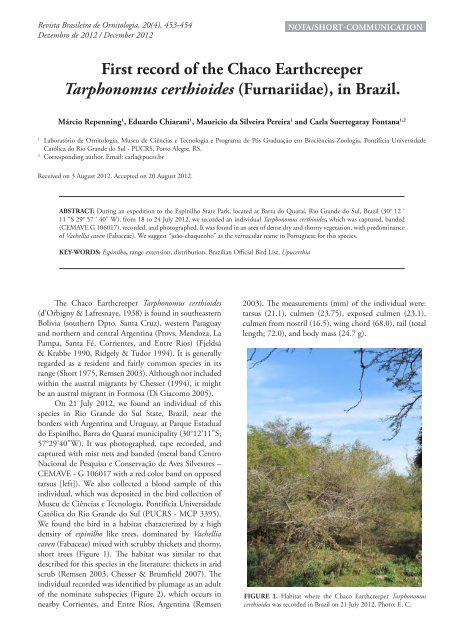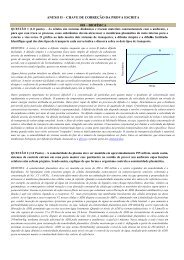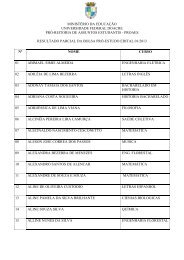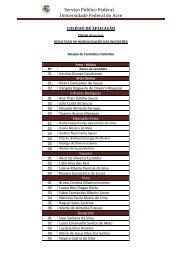452Predation of Long–tailed Silky Flycatcher (Ptilogonys caudatus) by Ornate Hawk–Eagle (Spizaetus ornatus) in a cloud forest of Costa RicaVíctor Acosta-Chaves, Fe<strong>de</strong>rico Grana<strong>do</strong>s-Rodríguez and David Araya-Huertasof 3200-3500 mm, temperature ranging between 14-26ºC (Cal<strong>de</strong>rón 1994) and altitu<strong>de</strong> varying from 1500to 1900 m.a.s.l. The landscape consists of mature forestand secondary regenerating forest, forest plantations ofCupressus lusitanica and Alnus acumminata, coffee fields,grasslands and infrastructure for hydropower generationwith a few farmhouses.When visiting this site on 5 December 2010 along adirt road surroun<strong>de</strong>d by secondary forest and grasslands,where the oscillation tank of the hydroelectric dam islocated (9°46’6.52”N; 83°51’8.02”W), we observed aflock of Emerald Toucanets (Aulacorhynchus prasinus)with a pair of Long-tailed Silky Flycatcher (P. caudatus)foraging in a bush (Lauraceae) at the bor<strong>de</strong>r of the roadsi<strong>de</strong>at about 7h 30 min. While we watched those birds, anOrnate Hawk-eagle emerged from the surrounding trees,then gli<strong>de</strong>d towards the bush and captured a LongtailedSilky Flycatcher while it was eating a fruit. At thatmoment, the Emerald Toucanets and the other LongtailedSilky Flycatcher that survived the attack escaped tothe secondary forest for protection, as even bigger toucansare also potential preys according to literature (Rangel &Enriquez 1993). The hawk-eagle flew very quickly to the<strong>de</strong>nse vegetation on the other si<strong>de</strong> of the road as we lostsight of the raptor.The Long-tailed Silky Flycatcher is en<strong>de</strong>mic tothe highlands of Costa Rica and western Panama andinhabits middle and highland forest (it occurs at around1600 m.a.s.l. to timberline). This bird can use partiallyopen areas for feeding (Skutch 1965, Stiles & Skutch1989). To our knowledge, this is first predation reportinvolving an adult Long-tailed Silky Flycatcher andthe family Ptilogonatidae as a whole, since only nestpredation reports are avaliable for this species. (Skutch1965). This observation highlights the importance ofpredation reports obtained in the field, as many of thepasserine birds consumed by the Ornate Hawk-Eaglewere not i<strong>de</strong>ntified to species level in studies based onpellet or bones analysis (Klein et al. 1988, Rangel &Enriquez 1993). Furthermore, these records contributeto a better un<strong>de</strong>rstanding of the habits of this predatorin cloud forests, as current knowledge is limited to thehumid lowlands.ACKNOWLEDGMENTSWe thank the “Estación <strong>de</strong> Biología Tropical yAcuicultura Río Macho” for lending us facilities for birdwatching. To Oscar Ramirez, Pablo Camacho, PauloAraya, Juan Vargas and Roberto Vargas for data onsightings of the species, and for joining us in multipleoccasions to watch these birds of prey. Also thanks toRyan Phillips, Carmen Hidalgo, Otto Monge, PabloCamacho, Oscar Ramirez, Haiany Miranda and IgnacioEscalante for suggestions improved the manuscript.REFERENCESBoinski, S.; Kauffman, L.; Westoll, A.; Stickler, C. M.; Cropp, S& Ehmke, E. 2003. Are vigilance, risk from avian predators andgroup size consequences of habitat structure? A comparison ofthree species of squirrel monkey (Saimiri oerstedii, S. boliviensis,and S.sciureus). Behaviour, 140 (11, 12): 1421-1467.Cal<strong>de</strong>rón, R. 1994. Rubiáceas y arbustivas <strong>de</strong> la Estación BiológicaTropical Río Macho, Orosi, Cartago. Un<strong>de</strong>rgraduate Thesis.Heredia: Universidad Nacional <strong>de</strong> Costa Rica.Clinton, J.; Gartsi<strong>de</strong>, M & Kainer, M. 1991. Ornate Hawk–Eaglefeeding on Green Iguana. Journal of Raptor Research, 25 (1): 19-20.De Luna, A. G.; Sanmiguel, R.; Di Fiori, A & Duque E. F.2010. Predation and Predation Attempts on Red Titi Monkeys(Callicebus discolor) and Equatorial Sakis (Pithecia aequatorialis)in Amazonian Ecua<strong>do</strong>r. Folia Primatol, 81: 86-95. DOI:10.1159/000314948.Haymann, E. W. 1990. Reaction of wild tamarins, Saguinus mystaxand Saguinus fuscicollis to avian predators. International Journal ofPrimatology, 11(4): 327-337.Klein, B. C.; Harper, L. H.; Bierregaard, R. O. & Powell, G.V.1988. The nesting and feeding behavior of the Ornate Hawk-Eagle near Manaus, Brazil. The Con<strong>do</strong>r, 90: 239-241.Lyon, B. & Kuhnigk A. 1985. Observations on nesting OrnateHawk-eagles in Guatemala. Wilson Bulletin, 97: 141-147.Madrid, J. A.; Madrid, H. D.; Funes, S. H.; López, J.; Botzoc, R &Ramos, A. 1991. Biología <strong>de</strong> la reproducción y comportamiento<strong>de</strong>l Águila Elegante (Spizaetus ornatus), en el Parque Nacional <strong>de</strong>Tikal, p. 157-187. In: Whitacre, D. F.; Burnham, W. A. & Jenny,J. P. (eds.). IV Reporte <strong>de</strong> avance, Proyecto Maya: Uso <strong>de</strong> avesrapaces y <strong>de</strong> otros integrantes <strong>de</strong> la fauna como indica<strong>do</strong>res <strong>de</strong>lmedio ambiente, para el diseño <strong>de</strong> áreas protegidas y para fortalecerla capacidad <strong>de</strong>l personal <strong>de</strong>l lugar en or<strong>de</strong>n a la conservación enAmérica Latina. Boise: The Peregrine Fund.Marquez, C.; Bechard, M.; Gast, F & Vanegas, V. 2005. Avesrapaces diurnas <strong>de</strong> Colombia. Bogotá: Instituto <strong>de</strong> Investigación <strong>de</strong>Recursos Biológicos “Alexan<strong>de</strong>r von Humboldt”.Rangel, J. & Enriquez, P.. 1993. Nest record and dietary itemsfor the Black Hawk-eagle (Spizaetus tyrannus) from the YucatánPeninsula. Journal of Raptor Research, 27 (2): 121-122.Robinson, S. 1994. Habitat selection and foraging ecology of raptorsin Amazonian Peru. Biotropica, 26 (4): 443-458.Skutch, A. 1965. Life history of the Long-tailed Silky Flycatcher withnotes on related species. The Auk, 82: 375-426.Stiles, G. & Skutch, A. 1989. A Gui<strong>de</strong> to the Birds of Costa Rica.Ithaca: Cornell University Press.<strong>Revista</strong> <strong>Brasileira</strong> <strong>de</strong> <strong>Ornitologia</strong>, 20(4), 2012
<strong>Revista</strong> <strong>Brasileira</strong> <strong>de</strong> <strong>Ornitologia</strong>, 20(4), 453-454Dezembro <strong>de</strong> 2012 / December 2012NOTA/SHORT-COMMUNICATIONFirst record of the Chaco EarthcreeperTarphonomus certhioi<strong>de</strong>s (Furnariidae), in Brazil.Márcio Repenning 1 , Eduar<strong>do</strong> Chiarani 1 , Mauricio da Silveira Pereira 1 and Carla Suertegaray Fontana 1,21Laboratório <strong>de</strong> <strong>Ornitologia</strong>, Museu <strong>de</strong> Ciências e Tecnologia e Programa <strong>de</strong> Pós Graduação em Biociências-Zoologia, Pontifícia Universida<strong>de</strong>Católica <strong>do</strong> Rio Gran<strong>de</strong> <strong>do</strong> Sul - PUCRS, Porto Alegre, RS.2Corresponding author. Email: carla@pucrs.brReceived on 3 August 2012. Accepted on 20 August 2012.ABSTRACT: During an expedition to the Espinilho State Park, located at Barra <strong>do</strong> Quaraí, Rio Gran<strong>de</strong> <strong>do</strong> Sul, Brazil (30° 12 ‘11 “S 29° 57 ‘ 40” W), from 18 to 24 July 2012, we recor<strong>de</strong>d an individual Tarphonomus certhioi<strong>de</strong>s, which was captured, ban<strong>de</strong>d(CEMAVE G 106017), recor<strong>de</strong>d, and photographed. It was found in an area of <strong>de</strong>nse dry and thorny vegetation, with pre<strong>do</strong>minanceof Vachellia caven (Fabaceae). We suggest “joão-chaquenho” as the vernacular name in Portuguese for this species.KEY-WORDS: Espinilho, range extension, distribution, Brazilian Official Bird List, UpucerthiaThe Chaco Earthcreeper Tarphonomus certhioi<strong>de</strong>s(d’Orbigny & Lafresnaye, 1938) is found in southeasternBolivia (southern Dpto. Santa Cruz), western Paraguayand northern and central Argentina (Provs. Men<strong>do</strong>za, LaPampa, Santa Fé, Corrientes, and Entre Rios) (Fjeldså& Krabbe 1990, Ridgely & Tu<strong>do</strong>r 1994). It is generallyregar<strong>de</strong>d as a resi<strong>de</strong>nt and fairly common species in itsrange (Short 1975, Remsen 2003). Although not inclu<strong>de</strong>dwithin the austral migrants by Chesser (1994), it mightbe an austral migrant in Formosa (Di Giacomo 2005).On 21 July 2012, we found an individual of thisspecies in Rio Gran<strong>de</strong> <strong>do</strong> Sul State, Brazil, near thebor<strong>de</strong>rs with Argentina and Uruguay, at Parque Estadual<strong>do</strong> Espinilho, Barra <strong>do</strong> Quaraí municipality (30°12’11”S;57°29’40”W). It was photographed, tape recor<strong>de</strong>d, andcaptured with mist nets and ban<strong>de</strong>d (metal band CentroNacional <strong>de</strong> Pesquisa e Conservação <strong>de</strong> Aves Silvestres –CEMAVE - G 106017 with a red color band on opposedtarsus [left]). We also collected a blood sample of thisindividual, which was <strong>de</strong>posited in the bird collection ofMuseu <strong>de</strong> Ciências e Tecnologia, Pontífícia Universida<strong>de</strong>Católica <strong>do</strong> Rio Gran<strong>de</strong> <strong>do</strong> Sul (PUCRS - MCP 3395).We found the bird in a habitat characterized by a high<strong>de</strong>nsity of espinilho like trees, <strong>do</strong>minated by Vachelliacaven (Fabaceae) mixed with scrubby thickets and thorny,short trees (Figure 1). The habitat was similar to that<strong>de</strong>scribed for this species in the literature: thickets in aridscrub (Remsen 2003, Chesser & Brumfield 2007). Theindividual recor<strong>de</strong>d was i<strong>de</strong>ntified by plumage as an adultof the nominate subspecies (Figure 2), which occurs innearby Corrientes, and Entre Ríos, Argentina (Remsen2003). The measurements (mm) of the individual were:tarsus (21.1), culmen (23.75), exposed culmen (23.1),culmen from nostril (16.5), wing chord (68.0), tail (totallength; 72.0), and body mass (24.7 g).FIGURE 1. Habitat where the Chaco Earthcreeper Tarphonomuscerthioi<strong>de</strong>s was recor<strong>de</strong>d in Brazil on 21 July 2012. Photo: E. C.










